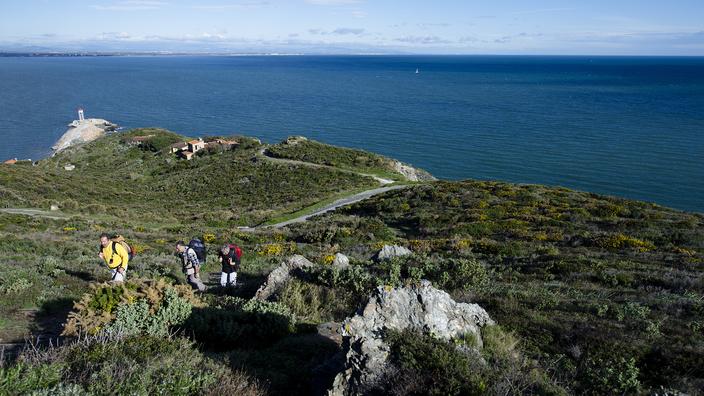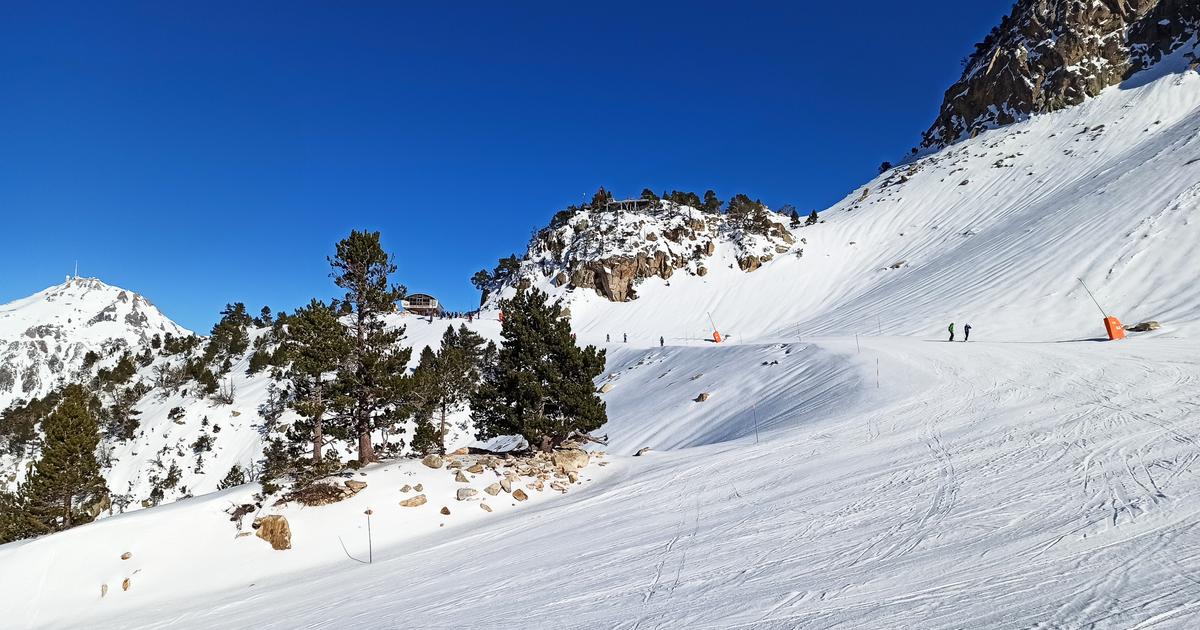It is a country between
mar y muntanyes,
between a Mediterranean open to Africa and the snow-capped Pyrenees. A country bathed in the yellow of the sun and streaked with red. Its coast, described as "vermeille" for the red hue taken by its rocks in the east, suddenly makes you forget the long litany of Languedoc beaches. The Pyrenees or more exactly the Albères massif come here to take a plunge into a riot of colors to the delight of painters ... and hiking enthusiasts.
On these 20 km of wild and rough coast, a coastal path wanders along the Costa Vermella, twists from fishing ports to rocky coves and ends up flying over cliffs powdered with sea birds before finding a beach of pebbles licked by the Mediterranean.
This sporty walk in the middle of steep landscapes combines historical points of interest and luminous points of view with the mountains as a backdrop and the vineyards of Banyuls-sur-Mer on the hillside.
Read the file: Hiking in France: itineraries, advice ... the Figaro guide
From Port-Vendres to Banyuls, hiking in practice
13 km> 5 hours> difference in level +450 / -450 m> Discontinuous yellow markings, absent in urban areas (see our practical guide to get your bearings on the route).
IGN 2549 OT Map - Banyuls / Col de Perthus / Côte Vermeille
Departure: from Perpignan, take the D914 to Port-Vendres.
Park not far from the station (8 Route de la Gare).
Parking is free.
GPS point: N 42.514198, E 3.105750
From Port-Vendres to the Redoutes trail
Port-Vendres, the first fruit port in the Mediterranean.
Christophe Migeon / Le Figaro
On the basins of
Port-Vendres
, voracious cranes end up stripping cargo ships withered by too long frequenting the sea. Pallets and containers spring from the metallic entrails in a hum of diesel engines, an agitation which comes as a reminder that since its founding by the Phoenicians in the 6th century, the port has continued to maintain trade relations with the Great South.
If Collioure has made anchovy a specialty, Port-Vendres has become the main entry point for fruits and vegetables from the Maghreb and West Africa. Before turning your back on this noisy ballet of Moroccan oranges and Senegalese bananas, think about taking a look at
the Notre-Dame de Bonne Nouvelle church,
whose Hispanic bell tower has dominated the quays since the 19th century. The wives of the fishermen came there to pray to the Virgin for the safe return to the quay of their husbands. Following the road that runs along the port area, the route passes a roundabout and enters a track. The coastal path is called here “
Redout trail
”. A succession of austere fortifications -
Béar redoubt, Fanal redoubt, Mailly redoubt
- most of them erected by the indefatigable Vauban to protect the entrance to the port, crowns the cliffs with schist.
A barrel of cannon planted in a rock at the surface of the water serves as a beacon for fishermen and as a perch for cormorants who drip their feathers there quite at their ease.
Read also: Buller at the Bubbles of the sea in the Pyrénées-Orientales
Around Cap Béar
At 80 meters above the sea, the lighthouse of Cap Béar, very elegant with its pink marble facing from Villefranche-de-Conflent.
Christophe Migeon / Le Figaro
Under the harsh caress of the squalls, the bushes to which the maquis has entrusted the mission of perfuming the coast, snort along the slopes: thyme, Spanish broom, rosemary, cistus and lavender release their resolutely Mediterranean fragrances on the way. In this bed of native plants, intruders brought back from distant journeys by sailors with blue coats and green fingers mingle: witches' claws, prickly pears, agaves from the Americas ... origin wisely replanted in the gardens, has become beautiful at the first gust of wind.
And it must be said that the region does not lack wind.
It is even a little the specialty of
Cap Béar
, a promontory of reddish-brown cliffs pointed out to sea like a knife blade, where the Tramontana feels its wings: 191 km / h in January 2009!
Watch out for hats ... At 80 meters above the sea, the
Cap Béar lighthouse
, very elegant with its pink Villefranche-de-Conflent marble facing, winks every 20 seconds at the Grande Blue.
Read also: Hike in the heart of Béarn, around the giant Ossau
Creeks and dynamite
Here in the direction of Balanti beach, the trail decided to flirt with the sea, which does not prevent the drop.
Christophe Migeon / Le Figaro
Towards the south, we can already see the red tiles of Banyuls. They seem so close like a gull. But it is better to spare your strength, because nature, which does not like straight lines, forces the coast to make a few convoluted digressions. Do not believe either that the pretext of a coastal hike, the route forgets to climb. Because here, the path has decided to flirt with the sea. Like a frozen lover, it comes close to nothing, teases its rocky coves, brushes its sandy beaches, and suddenly, for fear of having done too much, Climb quickly up the slope and flee through the broom, ashamed and confused. This banter brings us all the same more than 400 m of elevation: Santa Catarina cove, Balanti beach, Bernardi beach and
Paulilles cove
.
Under the umbrellas of umbrella pines, old buildings tell the story of the
Nobel dynamite factory
which from 1875 until 1984 supplied France and the world with 12 to 20 tons of explosives per day. Sticks that had their moment of glory during the construction of the Panama Canal, the Mont-Blanc tunnel, the development of the Mururoa atoll or the construction of the Kourou space base. A strange factory, with its workshops ambushed behind merlons and escarps worthy of a fortress, a village cut off from the world, with its school, its grocery store, its stables and its canteen, and then well away, facing a bouquet of palm trees adorned with a fountain, the director's house, who, understandably, preferred to put a little distance between his privacy and an activity where clumsiness came at a high price. As in January 1882,when 19 people were killed in an explosion caused by mishandling.
Arrival in Banyuls
View of Banyuls from Cap Béar.
Christophe Migeon / Le Figaro
After the
Cap d'Ullastrell
, it takes less than an hour to reach
Banyuls
and its oleander gardens via
Cap Castell de Vello
and
Cap des Elmes
.
All around, rows of small black vines, tortured like bonsai, scratch the leather of the hills.
Wine is to Banyuls what melon is to Cavaillon: an ancestral tradition.
Since 1285, the Catalan vineyards have flourished on the slopes of the Albères in plots protected by dry stone walls to produce natural sweet wines, an appellation reserved for wines that have been transferred sweetened only by their grapes.
Before taking the road to Port-Vendres, some thirsty for the dust of the roads will perhaps be seduced by a tasting of the wines of the country.
There is no shortage of cellars ...
Practical notebook
ROUTE
Go down towards the port, it is bypassed by the south via the future European path E12. Take the coastal path on the left at the large roundabout. It passes under the ruins of batteries and redoubts and begins to climb the slope. After 1.5 km, it is Cap Béar and its lighthouse. Go to the end of the promontory for the view. Then take the path again, we can already see Banyuls but we are far from having arrived. Succession of coves and beaches: Santa Catarina cove, Balanti beach, Bernardi beach and finally Paulilles cove where it takes a good hour to visit the rehabilitated site of the old dynamite factory. A small museum recalls the heyday of the workshops as well as the accidents that bloodied their history. The path then goes through the Cape of Ullastrell towards Banyuls.
Three solutions to return to Port-Vendres: on foot from the interior (then count 3 hours more), by bus at 1 €, thank you the Departmental Council (last departure in front of the tourist office at 6:20 p.m., arrival at Port-Vendres stop
Les quais
at 6.35 p.m.) or by train (last departure at 4.30 p.m., arrival 5 minutes later).
On the coastal path, south of Port-Vendres.
Christophe Migeon / Le Figaro
GOOD ADDRESSES
Maillol Museum in Banyuls-sur-Mer.
The “Métairie” where the painter, engraver and sculptor Aristide Maillol lived from 1910, in the calm of the Roume valley, is today a museum.
Entrance 5 €.
Roume Valley, 66650 Banyuls-sur-Mer.
Phone.
: 04 68 88 57 11.
Restaurant Chez Pujol.
Seafood and wild fish cut in the dining room.
Chez Pujol, 17 Quai Pierre Forgas, 66660 Port-Vendres.
Phone.
: 09 74 56 64 01.
Wine tasting:
Grande Cave de Terres des Templiers
, open every day (including public holidays), Monday to Sunday, 10 am to 7:30 pm Route du Mas Reig, 66650 Banyuls-sur-Mer.
Phone.
: 04 68 98 36 70.
L'Étoile cooperative cellar
, Monday to Sunday from 9:30 a.m. to 12:30 p.m. and from 2 p.m. to 5:30 p.m. and in the summer season, every day from 9:30 a.m. to 8 p.m.
26 Avenue du Puig del Mas, 66650 Banyuls-sur-Mer.
Phone.
: 04 68 88 00 10.
OR SLEEP
The Relais des Trois Mas.
4 star hotel with 23 rooms and suites open to the sea. The swimming pool and jacuzzi will be welcome after the hike.
Room from 180 € in high season.
Le Relais des Trois Mas, Route de Port-Vendres, Collioure.
Phone.
: 04 68 82 05 07.
Hotel Le Catalan.
Located on the heights of Banyuls, 300 m from a small cove.
View of the village, the mountains and the sea. From € 79 per double room.
Le Catalan, Route de Cerbère, Banyuls-sur-mer.
Phone.
: 04 68 88 02 80.















